Document Analysis
The questioned document is examined and the handwriting is studied for any evidence of disguised writing and also to check that the writing present can all be attributed to the same author. It may be useful to submit all of the pages of the documents in question to check for the number of authors present and also to provide the largest possible sample size of the questioned individual's writing for comparison purposes. All of the characters present in the questioned writing are then studied and the natural range of variation for each is determined. The style, shape, layout and spacing of the writing is also noted.
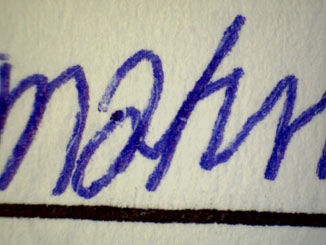 The reference writings are then also studied. In an investigation it may be important to either discount an author, i.e. determine that an individual did not write out the questioned writing, or to ascertain whether a person was responsible for writing out the questioned material.
The reference writings are then also studied. In an investigation it may be important to either discount an author, i.e. determine that an individual did not write out the questioned writing, or to ascertain whether a person was responsible for writing out the questioned material.
In any comparison it is essential to have a suitable amount of reference writing for each suspect. We would generally suggest ten to twelve versions of the questioned text which consists of a few sentences or paragraphs, or where larger volumes of writing are in question, perhaps only two or three pages. Please refer to our guidelines on how to obtain the most suitable reference samples.
The reference writing is then also studied to check that the sample of writing has all been written out by one person and also that it has been written out in a natural, undisguised writing style. It may be necessary to obtain course-of-business (handwriting produced in the course of an individual's everyday writings) reference writings in order gain a fuller sample of the individual's natural variation in their writing, rather than just a snap shot sample as shown by writing taken by request and for the purposes of the investigation.
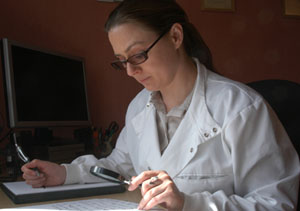 The questioned writing is then compared to the reference writing and the presence of significant similarities and differences is noted. If significant differences are consistently noted, it may be the result of reference writer not being responsible for producing any of the questioned writing. If significant similarities are noted and no significant differences are found, the questioned writing may be attributed to the reference writer, i.e. the author of the reference writing wrote out the questioned handwriting.
The questioned writing is then compared to the reference writing and the presence of significant similarities and differences is noted. If significant differences are consistently noted, it may be the result of reference writer not being responsible for producing any of the questioned writing. If significant similarities are noted and no significant differences are found, the questioned writing may be attributed to the reference writer, i.e. the author of the reference writing wrote out the questioned handwriting.
In some cases the evidence may be limited due to the availability of poor copy quality documents, small amounts of questioned and/or reference writings, very simple writing styles. The strength of the opinion may therefore be limited, i.e. not conclusive. Please refer to the range of opinions used for an explanation of our regularly used opinion strengths.
Questioned documents might include cheques, wills, invoices, letters of reference, drug lists from a crime scene, handwritten sales receipts, threat letters, anonymous letters, suicide notes and diary entries supporting alibis.
Analysis of signatures on documents
The forensic analysis of signatures is a very specialised form of handwriting analysis as the signature, while unusually only a small amount of writing, is a highly customized and stylized piece of writing. For many individuals it may be their most commonly used writing. For those who regularly sign their name many times a day, for example on business documents, their signature may become shortened, abbreviated or simplified into a quicker, illegible, but highly personalized scribble.
It is particularly important for the forensic document to examine the original questioned document if it is accessible, as valuable evidence can be obtained through the microscopic examination of the original signature.
Where more than one signature is in question, please submit all of your documents; this could help strengthen the evidence in the case.
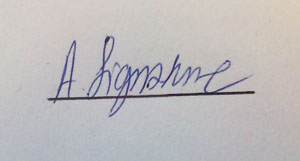 Ideally ten or more reference signatures by the named author will need to be submitted in order to determine whether or not the signature is genuine. Where signatures are found to be forged, it may in some cases, be possible to link them to a common author. If suitable reference writings are submitted and the forged signatures bear features of the forger's natural handwriting or signature style, the document examiner may be able to indicate the authorship of the forged signatures.
Ideally ten or more reference signatures by the named author will need to be submitted in order to determine whether or not the signature is genuine. Where signatures are found to be forged, it may in some cases, be possible to link them to a common author. If suitable reference writings are submitted and the forged signatures bear features of the forger's natural handwriting or signature style, the document examiner may be able to indicate the authorship of the forged signatures.
Examples of questioned signatures which may be submitted for forensic document analysis may be wills, cheques, contracts, benefit claim forms, bank account application forms, identity documents, tenancy agreements, sales receipts, delivery slips, insurance claim forms and associated invoices.
Altered handwriting or added handwritten or printed entries
Where a handwritten document is suspected of being altered or figures, words or paragraphs inserted, it may be possible to identify either a different author, or that a different type of ink has been used.
For example, the amounts in words and figures may have been altered on a handwritten or printed cheque. A word processed document may have had a paragraph or an additional page inserted.
Such altered documents could include any form of financial document or legal paperwork, such as cheques, contracts, invoices, wills.
Indented impressions of handwriting
In some cases, particularly where other forms of forensic analysis are not applicable or have not provided conclusive evidence, it may be useful to examine a document for the presence of indented impressions of handwriting. Indented impressions of handwriting are invisible marks pressed into the papers surface when one document is written out while resting on top of another page.
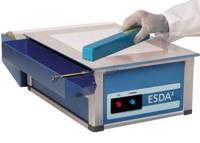 The page below will bear a record of the writings from the page above which can be revealed using an angled, oblique high intensity light or by using the electrostatic detection apparatus (ESDA). The ESDA technique is a non-destructive process which creates a permanent record of the impression marks without damaging the questioned document. Such indented impression marks could recover additional evidence to assist identifying an author, date, or a lead on a location or telephone number of possible suspects in a case.
The page below will bear a record of the writings from the page above which can be revealed using an angled, oblique high intensity light or by using the electrostatic detection apparatus (ESDA). The ESDA technique is a non-destructive process which creates a permanent record of the impression marks without damaging the questioned document. Such indented impression marks could recover additional evidence to assist identifying an author, date, or a lead on a location or telephone number of possible suspects in a case.
For instance, a threatening note may bear indented impressions that link it to blank note pad taken from a suspect's home, or bear impressions of a handwritten name or address that may lead the investigation further; a map recovered from a crime scene might reveal impressions of a name or location of a hostage; or an anonymous letter written in disguised handwriting may bear useful indented writings that can be matched to a suspects reference sample.
Torn edge pattern recognition
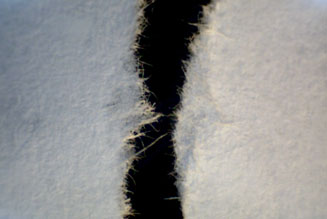 Microscopic analysis and the examination of the edge patterns and their sheared edge profiles can be used to match the torn edge of a page to another edge. For example, where a note pad page has been torn in half, and one half has been used as an anonymous letter, and the other half, or the remainder of the page and note book have been recovered from a suspect. It may also be necessary to match two halves of a financially or legally important torn document together conclusively.
Microscopic analysis and the examination of the edge patterns and their sheared edge profiles can be used to match the torn edge of a page to another edge. For example, where a note pad page has been torn in half, and one half has been used as an anonymous letter, and the other half, or the remainder of the page and note book have been recovered from a suspect. It may also be necessary to match two halves of a financially or legally important torn document together conclusively.
Reconstruction of shredded or torn documents
Where documents such as financial papers have been destroyed by shredding it can be possible to reconstruct the pages and recover the destroyed information. With the use of confetti style shredders the pages are turned into layers of thin, long strips: it is essential that you do not disturb the layers of shreds in the shredder bin, as these strata are formed by separate pages of documents. In the case of cross-cut or diamond cut shredders it may not always be possible to reconstruct the documents depending on the volume of shreds present as to little information is held on the smaller sized diamond cuts. If the cross-cut shreds are fairly long and only a few pages are present it may be possible to reassemble these. Where hand torn pages are present, the shapes and sizes of the sections can be used to match up pages along with any printed designs or text entries present. Please consult our document expert for advice for your specific case.
Reading of carbon-film typewriter ribbons
Often in cheque or benefit slip alteration cases an old-fashioned typewriter has been used to add in or alter word processed entries as the new characters can be easily positioned on the document and mistakes can also be lifted off using a correction tape fitted into the machine. It has been possible in a number of cases to link the carbon-film ribbon to a series of such altered documents as this type of ribbon records every character typed onto a document, as the character area is left as a blank image on the film.
Analysis of printed or photocopied document
 The microscopic study of photocopied or printed documents can sometimes reveal unique identifying marks or defects to link documents or match them to specific pieces of equipment. Scratched or damaged areas on the glass surface of a photocopier create unique patterns that are recorded with each copy made on that area of the machine. Damage to the rollers or photosensitive plates with printers and photocopiers may also be translated into each image they record. Such defective marks can also grow with age or use and can in some instances be used to estimate the age of a document produced by this piece of equipment. The photographic printing plates can also be linked to documents through blemishes or defects on the plate, and the documents that result from them can also be grouped together through such identifying marks.
The microscopic study of photocopied or printed documents can sometimes reveal unique identifying marks or defects to link documents or match them to specific pieces of equipment. Scratched or damaged areas on the glass surface of a photocopier create unique patterns that are recorded with each copy made on that area of the machine. Damage to the rollers or photosensitive plates with printers and photocopiers may also be translated into each image they record. Such defective marks can also grow with age or use and can in some instances be used to estimate the age of a document produced by this piece of equipment. The photographic printing plates can also be linked to documents through blemishes or defects on the plate, and the documents that result from them can also be grouped together through such identifying marks.
For example, a series of counterfeit bank notes, immigration papers or tickets can be linked to a single source or grouped into batches. An anonymous printed letter or document could be traced to a suspect's specific office printer or photocopier.
![]()
The business is temporarily closed,
we apologise for any inconvenience.
